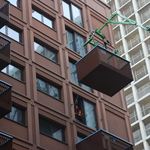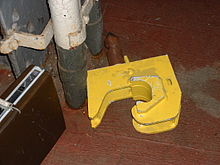Bright Idea for SEPTA: Regional Rail Lite (PhillyMag.com)
Less costly, more frequent service could become possible as soon as next year. Will SEPTA seize the day?
By
Sandy Smith | January 30, 2014 at 10:38 am
[This week’s big news out of 1234 Market Street is that, as part of its big capital project catch-up list,
SEPTA may purchase bilevel electric multiple-unit (EMU) railcars to increase capacity on its Regional Rail lines.
[...]
...more capacity is needed on Regional Rail, and bilevel railcars are a good way to provide it at peak commute times. But what about the rest of the day?
Thanks to
a proposed rule change, it is now possible to contemplate a solution that would add off-peak capacity while achieving one of the goals recommended in my earlier post on
ways to get more riders on board public transit in Philly.
The Philadelphia City Planning Commission likes this idea so much that
it touted it on its
Philadelphia Planeto blog last week. Boston is seriously considering this idea, and we should too.
It’s this: Run service on the Regional Rail lines using lightweight diesel multiple-unit (DMU) railcars.
Service of this type already operates in our region: New Jersey Transit’s River Line, which connects Trenton and Camden via a freight railroad line. New Jersey is currently in the process of extending this service south from Camden to Glassboro.
It’s proved more popular than originally forecast, but it cannot reach its full potential because of Federal Railroad Administration (FRA) safety rules. Because the River Line diesels do not meet FRA crashworthiness standards for mainline railroad equipment, they must be kept separate from those heavier railcars. The way the rule works on lines that both types of cars use is that the two types of equipment cannot use the line at the same time. That’s why you can’t travel between Pennsauken and Bordentown on the River Line after about 10:30 p.m.
The Obama administration has pledged to get rid of this “temporal separation” requirement this year. That opens up a world of possibilities for expanding Regional Rail service, and the lightweight railcars are the key to that world.
[...]
http://www.phillymag.com/news/2014/01/30/septa-regional-rail-lite-rapid-transit/
Here is the blog from the City of Philadelphia Planning Department:
Great ideas from Boston
January 17, 2014 | Tagged:
Citywide Vision,
Economic Development,
Making It Happen,
septa,
Transportation
[...]
The fact that the new building is adding on yet again to our concourse system and therefore connecting directly to Suburban Station (and with a slightly longer walk, subways and trolleys) is fantastic.
But might there come a point when we will need more or different service? How close are we to that point? And what’s the big idea that solves the problem at a reasonable price?
Well, it kind of depends on where everyone decides to live (and work, since we’re talking about any and all future growth). Our regional rail system is gaining riders every year, and is at or above capacity on many trains each day. Fortunately, SEPTA’s recent state funding package means they can go ahead and think about expanding the fleet within a reasonable timeframe. That simple act – creating longer trains – would certainly alleviate some of the problem. But what about frequency? What if longer trains at rush hour don’t help, when people are working different hours in different places? And while we’re seeing a TON of development in transit-rich neighborhoods and inner suburbs, we’re also seeing growth in places that aren’t as connected. What about those areas?
The answer may lie in Philadelphia2035. It wasn’t born there, but it made it in there for a reason. The “it” in question? A concept we call
“CityRail”, a fancy (and potentially silly) name for a simple concept: what if you could figure out a way to run higher frequency service along regional rail routes, and maybe even add infill stations here and there, thereby allowing people to interact with regional rail the way you would with a subway. No need to check a schedule, no need for special fare. A completely new way to conceive of existing infrastructure.
MUCH easier said than done. There’s a lot to consider:
1) How many (and what kind) of vehicles would we need to increase service to a given interval (say, every 15 minutes)?
2) Do we have space to store these vehicles and room to fit them in when the Center City Commuter Tunnel is often backed up already?
3) If you want them to behave like a subway, does that mean you need high-level platforms along the whole route?
4) Could SEPTA make enough money charging a city transit fare for a regional rail service?
5) And where in the heck would you fit additional stations?
Lo and behold,
an early answer arrives from Boston. Massachusetts Dept of Transportation (MassDOT) released a five-year spending plan along with
a longer-term vision for transit investment in Boston’s transit system, the MBTA. While there are some actual expansions proposed – new infrastructure where there is currently none – much of the improved service hinges on a simple thing:
a rule change from the Federal Railroad Administration that would allow lighter vehicles – what you might think of as light rail – to run on corridors previously reserved for heavier locomotive-driven trains. Mixed traffic, so to speak. Boston’s plan: buy a bunch of DMU’s (
diesel multiple unit vehicles), run them on existing and to-be-refurbished regional rail and abandoned freight routes at higher frequencies, and allow the existing regional rail stock to skip some of the inner stations, providing more traditional commuter service to outlying areas.]
[...]
http://philadelphiaplaneto.com/looking-forward-on-friday-great-ideas-from-boston/
And the Boston Report itself:
[...][
In a 65-page document, MassDOT Secretary Richard Davey outlined the goals of the agency, which includes projects on the state’s highways and bridges, as well as critical infrastructure changes along the tracks of the MBTA and Commuter Rail system. According to the report, over the next five fiscal years, MassDOT plans on spending roughly $12.4 billion on transit projects across the state.
[...]
If all goes according to plan, in the next 10 years MassDOT would like to roll out their “vision for the MBTA in 2024,” where additional DMU lines would run alongside existing Commuter Rail tracks and make connections to existing stations a lot easier.
According to a map produced by MassDOT as part of the report, the Indigo Line would expand in the next decade and make loops into Fort Point, near the Convention Center, as well as provide trips to Back Bay, and introduce a connector that could swing into Cambridge before making its way to North Station from Allston. There’s also a proposal to have DMUs travel alongside the Lowell and Rockport Lines, connecting to Boston.
A closer look at the map, specifically highlighting major points in the city, shows you how hopping on a proposed DMU train on the Indigo Line would help skip multiple station transfers. The darker purple line indicates where the DMUs would run. (Click to enlarge):

Click to enlarge
According to a Globe report that detailed the “Track 61” project, where an independent DMU line would run service from the Seaport District to Copley, a DMU train car costs around $4 million. In Davey’s capital plan, MassDOT would like to put $252 million toward DMUs—as well as toward expanding Silver Line services—to provide “reliable public transit to underserved communities in the Fairmount Corridor of Boston, Chelsea, and the North Shore.”
No DMUs currently operate in Massachusetts, according to T officials. But the Indigo Line will come into play once the DMUs are active, and the T increases the frequency of service on the Fairmount line first.
[...]
http://www.bostonmagazine.com/news/blog/2014/01/09/massdot-capital-plan-proposal/
I'd say that Obama and Trudeau have something else to chat about: Bringing Commuter Rail into this century as that pertains to virtual lock-step FRA/TC regs.







